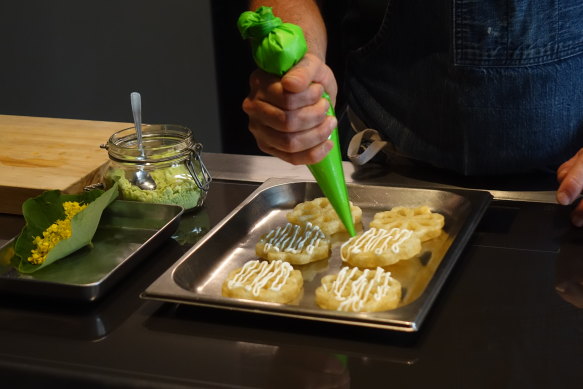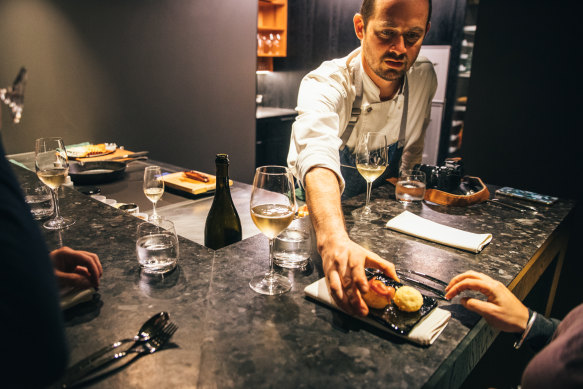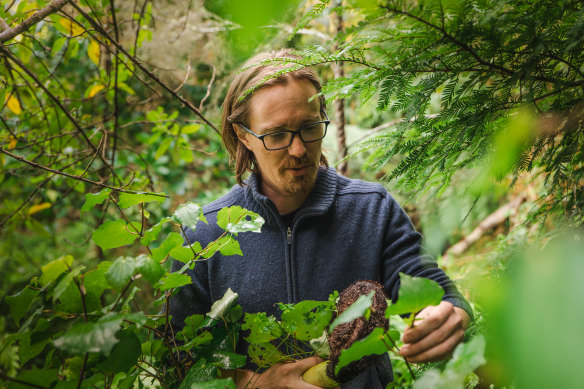A food revolution is happening in the land of ‘fush and chups’
Don’t think about what Mapu Test Kitchen has – think about what it doesn’t have. Because that’s what defines it.
Mapu Test Kitchen doesn’t have a sign out the front. It doesn’t have a proper dining room, or a kitchen filled with staff. It doesn’t have a reservation system. It doesn’t have opening hours. It doesn’t have any waiters. It doesn’t have a menu. It doesn’t even have a wine list.

There’s no menu at Mapu Test Kitchen.
This is a restaurant that’s not a restaurant, an eatery designed to subvert the entire hospitality model. It’s revolutionary; wildly daring. And it can be found – through the use of Google Maps, thanks very much – tucked away behind a café on a quiet street in Lyttelton, the bayside town on the outskirts of Christchurch.
Mapu is the brainchild of Giulio Sturla, a Chilean-born chef who found his way to New Zealand via Ecuador and the Basque Country of Spain. Giulio now stands before me, stirring a pot here, chopping a vegetable there, chatting as he works, prepping this lunch for one.
“I’m not trying to create dishes here, I’m trying to create flavours,” Giulio says as he puts the finishing touches on my second course, “a taste of summer in winter”, a mixture of preserved vegetables, herbs and spices plucked from the garden out the back here a few months ago. It’s a complex and entirely unique dish, sour, salty, gently spiced, and one that says a lot about what Giulio is trying to do in his restaurant-that’s-not-a-restaurant.

Mapu is the brainchild of Giulio Sturla.
See, the reason Giulio moved to New Zealand, after stints in some of the best restaurants in the world, was to live at the source of some of the finest produce he had been handling in those foreign eateries. The best seafood, the best lamb, the best vegetables – they were from New Zealand.
Imagine his frustration, then, when Giulio walked out to a trawler at the Auckland docks one day and asked to buy a few fish. No, he was told. This is all being exported. And that wasn’t unique – Giulio soon realised that the best produce was all being sent overseas.
Giulio’s career since that moment, his restaurants, his cuisine, has been a reaction to that discovery, a desire to go back to basics, to change the way Kiwis eat. Everything superfluous has now been chipped away. The radius for sourcing his food has shrunk dramatically. And now he has Mapu Test Kitchen, with six seats surrounding a hotplate and an oven.
Mapu Test Kitchen is representative of something powerful that is happening in New Zealand right now: a quiet culinary revolution; a shift to small-scale, local, sustainable, thoughtful, delicious dining. This country previously known for fush and chups and claims to pavlova is now a hotbed for gastronomic creativity and skill.
Check out the small-scale restaurants New Zealand boasts. Hiakai in Wellington (haikai.co.nz) is an incredible fine-diner in which chef Monique Fiso takes native ingredients and Maori techniques and treats them with haute cuisine skill. Good luck getting a booking.
See Rita (rita.co.nz), another tiny restaurant in the Kiwi capital, where an ever-changing set menu of just three dishes is served to appreciative audiences four nights a week. Or try Graze (grazewinebar.co.nz), where American expat chef Max Gordy insists on a hyper-local and sustainable ingredient list, to the point where he won’t even serve fish unless a spear fisherman drops it off at his door. Or dine at Hillside Kitchen (hillsidekitchen.co.nz), again in Wellington, where all the produce is foraged nearby or grown onsite.
The calling card for all these restaurants, their mantra, is “lots of little”. It means taking food back to its source; using small amounts of seasonal produce to create beautiful things.
“I feel like we are only just beginning to step into our power,” says Angela Clifford, the CEO of Eat New Zealand, an organisation founded by Giulio Sturla, a movement dedicated to reconnecting Kiwis to their land and their ocean through food. I’m chatting to Angela in her garden just outside Christchurch, among fruit trees and vegetable beds, as bees buzz around us and her dog nuzzles my leg in the hope of a pat.
“And ‘lots of little’,” Angela continues, “for me is the exciting part of where New Zealand food is up to. Owner-operator businesses like Mapu Test Kitchen – he’s got six seats. It’s that intimacy that I think is super-exciting. These are not just restaurants, they’re food experiences.”

Go foraging with chef Asher Boote of Hillside Kitchen in Wellington.
There are all sorts of ways tourists can enjoy those experiences. They can visit farmers markets, which take place across the country on weekends. They can do cooking classes at the likes of Hapuku Kitchen (hapukukitchen.co.nz), near Kaikoura on the South Island, where the produce is all grown or caught locally. They can go foraging with chef Asher Boote of Hillside Kitchen in Wellington.
Eat New Zealand can create these itineraries. Head to the website (eatnewzealand.nz), plug in your destinations, and select from the lo-fi food experiences available. This is how to tap into New Kiwi cuisine.
“What is New Zealand’s national dish?” Angela muses. “There isn’t one. It’s not fish and chips. It’s not pavlova. I don’t think there’s a dish or a set of ingredients – I think there’s a way of being. There’s a form of connection with our ocean and our land that really speaks to who we are.”
Giulio Sturla has that connection.
Here’s how Mapu Test Kitchen works: you can’t make a booking, but you can buy a ticket. Periodically, Giulio offers tickets to dine at the test kitchen, via his website. If you nab a spot, you will arrive on your given day and sit at the six-seat bench in front of Giulio’s small kitchen and be served the dishes Giulio has created that day, and poured the wines Giulio has opened.
You won’t recognise any of those dishes. Giulio’s food isn’t an expression of a style or a technique, but of a place. This place.
So you might recognise the ingredients because everything will be local, everything will be foraged from the surrounding hills, or pulled from the ocean nearby, or farmed or hunted in the local area.
The first dish I’m served is a meeting of familiar and unfamiliar flavours: a small tart using two peaches, one wild and slightly bitter, the other farmed and sweet. Next is that taste of Giulio’s summer garden in winter. Then there’s a small gougere made with aged NZ cheddar, topped with jamon that Giulio cured himself over a period of five years.
This symphony of cuisine is only just building. Next there’s a single scampi, very lightly heated with charcoal, served with beurre blanc on a bed of noodles.
“Guess what the noodles are made from,” Giulio says as I pick up a forkful. Turns out it’s bananas, grown in the South Island, picked green, pounded and extruded, gently poached and cut into ribbons – a nod to Giulio’s time in Ecuador: “Even vegetables can tell a story.”
The next dish is New Zealand lamb, the stuff that usually gets sent overseas, seared and served with a mille-feuille of silverbeet leaves, with foraged porcini mushrooms and a rich sauce made from the bones of that leg of jamon.
This isn’t exactly mum’s pavlova. It’s not fish and chips down at your local. It’s food of impressive skill and thought, where lots is made of little.
Tickets for “dining experiences” at Mapu Test Kitchen are released monthly, and cost $NZ300 ($276) a person for a five-course meal cooked by Giulio, with matching non-alcoholic beverages, or $NZ395 ($363) a person for food with matching wines. See mapu.co.nz
The writer travelled as a guest of Tourism New Zealand and Wellington on a Plate
Sign up for the Traveller Deals newsletter
Get exclusive travel deals delivered straight to your inbox. Sign up now.